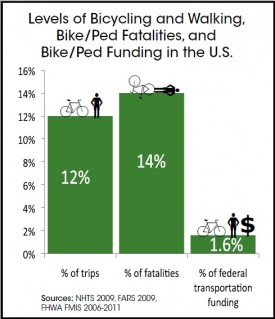
Despite the fact that 13.6 percent of Washington traffic fatalities are people either walking or biking, the state allocates only 0.5 percent of its transportation budget (and 2.7 percent of its federal funds) to walking and biking projects.
Seattle has fourth highest walking and biking commuter mode share in the country at 11.5 percent (not counting people using transit). The number of people biking to work in Washington grew 116 percent between 1990 and 2009, while the number of people walking grew by 14 percent.
Yet the state continues to invest disproportionately in automobile transportation. Infused with data from the recently-released 2012 Alliance for Biking and Walking Benchmarking Report, the Bicycle Alliance of Washington calls on the state to at least provide funding for the transportation choices people in the state already make.
From the Bicycle Alliance of Washington:
Washington ranks tenth as a safe place to bike and fourteenth for pedestrian safety ranking behind North Dakota, South Dakota, and Nebraska, according to a new report, Bicycling and Walking in the United States: 2012 Benchmarking Report, released today by the Alliance for Biking & Walking.“
This report comes at a critical moment as Governor Gregoire has just proposed a state transportation package of $3.6 billion that dedicates 72 percent to roads, only 4 percent to transit, and lacks funding for the popular Safe Routes to Schools Program or locally-requested state bicycle and pedestrian safety projects.
The Benchmarking Report highlights that while 4.5% of work trips in Washington state are by bicycle or foot, bicyclists and pedestrians account for 13.6% of traffic fatalities in Washington state. Much of the Washington state and Seattle data for the report was provided by the Bicycle Alliance of Washington, a state partner to the national coalition of over 200 organizations.
Lack of investment in bicycling and walking could be to blame as state and federal monies fall short of the choices that Washington residents make in how they get around. For biking and walking, the state currently allocates 2.7% of what it receives in federal monies and the state itself assigns less than 0.5% of its transportation budget to the Bicycle and Pedestrian Safety and Safe Routes to School Programs.
“The 2012 Benchmarking report points to the growing need for improved safety and mobility for the many residents who walk and bike. We are optimistic that the proposed transportation package can be improved to include investments in Safe Routes to Schools and other popular safety programs that residents across the state want,” says Blake Trask, Bicycle Alliance state policy director.
We’ll have more on the benchmarking report (which has all kinds of fun data) in a future post.








Comments
3 responses to “Washington State disproportionaltely underfunds walking and biking”
Not surprising. If you ride in any city in WA other than Seattle or Bellingham, you quickly realize that cycling, or even walking, are not design priorities. I lived in the south Sound for many years. It’s the land of bike lanes that mysteriously end and sidewalks to nowhere. I attended EWU in the late ’90′s and trying to find a safe route to ride around Spokane was pretty much an exercise in futility. Plus the fact that most of the other areas lack the traffic density of Seattle means that people are driving at higher speeds and really not looking for cyclists can make being on the road a seriously “extreme” sport.
These numbers really caught my eye because I like to read about bicycle commuting and try to understand the potential for giving people this option. This is an interesting and perhaps useful way to frame the counting. It is the first time I have come across a tally of “number of trips” in relation to walking and bicycling. The more usual references are number of commuters, or miles; those comparisons always show bicycle use as much smaller relative share of the commuter traffic. The link to the original posting shows that the numbers are comparisons of the 51 largest cities. The presentation above somewhat slurs the line of reasoning by talking about states and state funding. The basic point is good, but if one wants to make this case to others, it is important to be careful with the claims.
[…] State’s newest ferries are proving pricey http://crosscut.com/2012/01/26/ferries/21811/State-s-newest-ferries-are-proving-pricey-/ Washington State disproportionaltely underfunds walking and biking http://seattlebikeblog.com/2012/01/24/washington-state-disproportionaltely-underfunds-walking-and-bi… […]